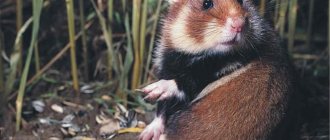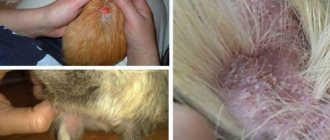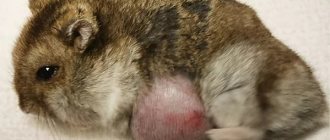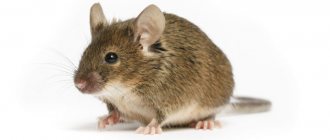Do hamsters have fleas? How to understand that a hamster is infected with parasites. Symptoms and causes of infection. Danger for hamsters when infected with fleas. What measures need to be taken. Correct methods of treatment. Mandatory measures when fighting fleas.
We try to care for our pets, please them in every possible way and try to protect them from all problems. But, unfortunately, it happens that our pets are attacked by parasites.
We all know that most often dogs and cats become infected with fleas, but when we see that the hamster begins to itch intensely, the question arises whether the problem can affect them. Here, owners should know that hamsters have fleas just like other animals. It is necessary to take measures as quickly as possible to avoid complications.
general description
If we talk about parasites such as fleas, it should be said that there are a huge number of varieties. For example, cats, dogs, mice and many others. But the fact is that they all have a fairly good appetite and, in search of food, do not go overboard when choosing a victim. So, a hungry dog flea can bite absolutely all warm-blooded animals.
Regarding the most common parasites, these include the cat flea. She can also attack hamsters, but only to satisfy her hunger. They do not take root on little furry friends, so after satisfying their hunger, they most often leave it. But parasites such as rats and mice pose a very great danger to animals.
Flea remedies
Before you make a choice, you need to realize that you cannot use drugs for dogs or cats. Any chemicals affect health, and bathing is contraindicated for hamsters. Every veterinarian knows about this, which is why they prescribe medications specifically for rodents.
Pet stores have the following offers:
- Le-artist;
- invermectin;
- stronghold;
- frontline;
- BioVax;
- Botfo;
- 8in1.
Preparations can be in different forms - injections, drops on the withers, sprays. If you are not planning a trip to the veterinary clinic and want to do everything yourself, we recommend Botfo or BioVax. Although experts often prefer Canina PETVITAL Verminex drops.
How does infection occur?
There are many sources from which hamsters can become infected; let’s look at the most common ones:
- Rodents. Of course, it is quite difficult to become infected from other rodents at home. But if you just bought a pet, then parasites could get on it at the market from other rodents.
- Animals. If you also have a dog or cat that walks outside, they can bring insects with them. Therefore, such new neighbors will look for food for themselves and attack all pets.
- Human. The host can also cause infections, but of course he does not bring them on his body. Infection occurs as follows: when a person walks on the street on shoes, flea eggs can get in, bringing them into the apartment, they fall, for example, into a crack in a wooden floor and perfectly grow into young individuals, and then go around the room in search of food.
- Plants. When freshly picked grass is brought to your pet, as in the previous version, there may be eggs on it. Without washing it, the eggs enter the apartment and develop into young parasites.
Prevention
To avoid the appearance of new animals in your pet, you need to keep its home clean. It is enough to change the sawdust twice a week and carry out wet cleaning once every 7 days. Fleas can also appear on sawdust brought from a pet store, so many owners put them in the oven for a few minutes. Thus, under the influence of high temperature, all bacteria and parasites die.
Hamster in a cage
If your hamster already had fleas, then for prevention purposes we treat your pet’s fur with a special product once a month, for example Frontline drops. They can be found in pet stores or specialized animal clinics.
Another way to leave fresh wormwood near the cage, its smell will scare away all unwanted guests. This effect does not last long; after 3-5 days it should be replaced with new grass.
In the wild, hamsters are plagued by various parasites, but in the home environment they are extremely rare. The most important thing is to notice in time, sound the alarm and take the necessary measures to get rid of fleas.
Great article 30
Symptoms of infection
At the initial stage of infection, it can be quite difficult to understand that a pet has fleas. After all, hamsters are very clean and constantly clean themselves and put their fur in order, and you might just think that the animal is once again preening itself. But the appearance of blood-sucking creatures causes great discomfort, so the furry friend itches a lot and bites off the fur.
It is also worth knowing a few features: the flea feeds in small portions, but very often, so several insects cause great inconvenience. You should also be aware that there is an enzyme in the insect's saliva that prevents blood from clotting; it causes itching, swelling and inflammation at the site of the bite. An allergic reaction to saliva causes pain.
If we consider the process of a tick bite, many people know that it uses an enzyme that anesthetizes, so it is imperceptible. But in the case of a flea, everything is different, the enzyme is missing, which causes very unpleasant and painful sensations.
Due to constant itching, the hamster scratches the skin and wounds appear, and areas of baldness are noticeable. In addition to very unpleasant sensations, there is a risk of infection.
When examining the animal, parting the fur, black grains will be visible on the skin. Such grains are nothing more than parasite excrement. It is quite difficult to notice adult individuals. Most often they are found on the neck of hamsters in the armpit area, but not many people can verify that they really exist.
As in any other situations, before treatment it is necessary to contact a veterinarian, who will help confirm or deny their presence. You will also be able to receive professional recommendations regarding treatment based on the current situation and the degree of infection.
Eye diseases
Due to their physiological characteristics, Syrian and Djungarian hamsters (as well as representatives of other species) often suffer from ophthalmological pathologies. One of the most common diseases is conjunctivitis (allergic, serous, purulent). Animals are also susceptible to cataracts, glaucoma, and uveitis (inflammation of the choroid).
You can tell if your hamster is sick by the following signs:
- spasmodic closing of the eyelids (spasm of the orbicularis oculi muscle);
- increased lacrimation;
- swelling;
- redness of the eyes;
- mucous or purulent discharge;
- sticking of eyelids.
If such symptoms appear, you should contact your doctor.
It is important to identify the causative agent of the disease (viruses or bacteria) and select appropriate drugs. Usually eye diseases in hamsters are treated with drops or ointments.
Bacteriostatic solutions (Sulfacetamide, Sofradex) and Tetracycline ointment are often used for this purpose.
In advanced cases, the veterinarian will prescribe an antibiotic for the hamster. And vitamin preparations help boost immunity, speed up recovery, and prevent relapse of eye disease. In the initial stages, you can use chamomile decoction or Furacilin solution.
In the absence of timely treatment, the risk of developing a purulent process, visual impairment or complete blindness increases.
Tumors, boils and abscesses
Often, ulcers and neoplasms of a benign or malignant nature are detected in rodents. These could be bumps on the body or a growth in the ear. Pathological formations may appear if the hamster fell from a height, was injured during a fight with relatives, or was attacked by other animals.
To understand the cause of the tumor, you need to show your pet to a veterinarian.
An abscess in a hamster can form from a regular scratch or small wound. After infection penetrates, pus accumulates in the affected area (under the skin). The abscess looks like a swelling that causes pain when pressed. An abscess can form due to prolonged inflammation of the cheek pouches. The disease is treated surgically.
Often, rodent owners worry about why their hamster has large testicles. More often this phenomenon is normal and indicates readiness for reproduction. But sometimes enlargement of the genital organs is associated with illness:
- the eggs became swollen and their size became more than ¼ of the animal’s body;
- testicles interfere with walking;
- the animal is lethargic, eats poorly, passive;
- the testicles turned red and became hot to the touch;
- the hair on the genitals has completely fallen out;
- hamster tries to gnaw testicles.
If such symptoms appear, you should immediately take your pet to the doctor. Especially if the appearance of alarming signs was preceded by a fall, severe bruise or other injury.
Oncological formations are treated surgically. The sooner the surgery is performed, the greater the chance of a full recovery. If metastases appear, the pet will have to be euthanized. The same should be done if the tumor is localized in a hard-to-reach place, for example in the mouth.
Health Hazard
Of course, the very presence of parasites and their bite are not fatal, but the danger is still present and the consequences can be quite serious:
- A hamster can become infected with helminths in the process of biting parasites out of its fur. Most often, after flea treatments, an anti-helminth drug is given.
- Remember that these parasites carry typhus, plague and salmonellosis, diseases that are fatal.
- Skin diseases appear, which without the necessary treatment can cause serious complications.
- Remember that the hamster suffers a lot due to the bites and constant itching, which causes stress. Their appetite decreases, sleep is disturbed, which leads to weight loss. The pet becomes lethargic, but at the same time can show aggression.
First aid for a pet
If your hamster experiences itching, you should immediately take it to a specialist for examination. The doctor will conduct an examination, take the necessary tests, make a diagnosis and prescribe treatment.
Recommendations for the treatment of diseases are as follows:
- A special diet is prescribed.
- To heal wounds, it is recommended to give the rodent flax seeds.
- The cage, as well as the accessories in it, require disinfection.
- The litter needs to be replaced.
- A sick hamster is isolated from other pets.
- If the cause of the itching is parasites or scabies, then ivermectin or another insecticide is prescribed.
- If lichen is detected, antifungal ointments are prescribed.
For effective treatment, it is important to follow all doctor’s recommendations regarding the duration of treatment and frequency of treatment of the animal. It is forbidden to wet or bathe the hamster, as well as self-medicate
Even if the parasites were identified independently, the dosage is determined by the veterinarian. Medicines are toxic to small animals and can cause their death.
Don't forget that hamsters are animals that sometimes scratch themselves for no reason. But if it has been noticed that the baby is itching, sneezing, and bald spots are forming on the body, you need to seriously think about the state of your pet’s health. A visit to the veterinary clinic, even for a routine examination, will not harm anyone, but rather will calm the worries of the owner of the furry baby.
Correct treatment
First of all, you need to understand that parasites do not live on your furry friend, they appear on it only to satisfy their hunger. They live and breed indoors. To get rid of them, it is not enough to treat the hamster; it will be completely ineffective. It is necessary to undertake complex processing. If there are other animals in the house, they also need to be treated, in addition to this, the room itself will need to be treated, this is the only way to achieve a positive result.
Because hamsters can have skin conditions, only a veterinarian can make a diagnosis regarding the presence of fleas. You should not diagnose the disease yourself and prescribe treatment; it may be ineffective, and in some cases even dangerous.
Basic information
As a rule, ectoparasites do especially well in situations where animals are kept in close and crowded conditions. In addition (and unfortunately), lice and fleas often appear on animals that often participate in exhibitions. The reason for this is unsatisfactory veterinary control and the lack of disinsection of exhibition premises after receiving the next batch of animals. From pet to pet (most often) parasites are transmitted through direct contact, but for the same fleas, infection occurs when a cat/dog ends up in a room where there are parasite larvae.
The life cycle of bloodsuckers of different species can differ significantly from each other. So, unlike fleas, lice survive their entire life cycle on an animal. Adult female insects lay eggs, sticking them tightly to the hair shafts. In the literature they are often called “nits”. Since they have a “camouflage” color, only an owner with certain experience can see signs of infection at first glance. Nymphs emerge from the eggs, an intermediate stage. They look like adult lice, reduced in size several times. They molt several times and become adults. The entire development process from egg to adult takes 2-4 weeks. The life cycle of lice eaters is approximately the same.
What about fleas? Given their prevalence in the external environment, it is not surprising that these parasites are most often the source of problems for animals. Adult females lay eggs, which, unlike lice, are not firmly attached to the fur. They fall, rolling into a variety of cracks and potholes in the floor. When the air temperature is positive and the humidity is at least 65%, the eggs ripen and the larvae emerge from them.
The latter begin to feed intensively, and almost any organic matter is suitable for them to eat: rotten leaves of indoor plants, feces, dried skin, etc. After going through several molting cycles, the larva pupates, and then an adult flea emerges from the cocoon. The full development cycle, from the moment of oviposition to hatching (in the best case) takes at least 15 days. The larval stage and, subsequently, the cocoon, can last for weeks or even months, which ensures the continuity of the infection process. This is how entomosis in cats and dogs became the most common parasitic diseases...
The biggest problem caused by lice, fleas and lice eaters is severe itching, blood loss and loss of rest, appetite and sleep. Anemia can be very serious in young puppies and kittens. Parasites can infect your pets with helminths, which are also very dangerous for their body. They are also mechanical carriers of many infectious diseases.
How to properly process
- The first thing to do is to thoroughly clean the room. To do this, we use a vacuum cleaner, we try to touch hard-to-reach places, be sure to vacuum the carpets, all corners, animal bedding, and all upholstered furniture.
- Next you need to do wet cleaning. To do this, special insecticidal agents are used that help destroy adults, larvae and eggs. The choice of insecticides is now very large; you can purchase solutions, sprays, and powders. When processing the room, be sure to pay attention to hard-to-reach places. Treat cracks, baseboards, and areas behind furniture.
- Be sure to wash the cage and all accessories, use soap and hot water to do this, you need to do such procedures as often as possible. Replace the bedding, you can use shavings from coniferous trees, the smell repels parasites.
Causes
Since it is impossible to simply ask your pet about the reasons for such behavior, all that remains is to make assumptions based on the needs of the animal and its natural instincts. Most often, the desire to try a cage on a tooth is caused by one of the following:
Physiological need for grinding teeth
It is not without reason that hamsters belong to the order of rodents, and that is why their attention is attracted by the metal rods that surround the pet most of its life. Of course, with great pleasure he would gnaw on dry branches of fruit trees or plant roots, as happens in nature, but in their absence in the cage, there is nothing left to do but grab the metal wire.
The pet is bored
Another fairly common reason is the inability to carry out normal life activities in the limited space of a cell and, as a result, the search for new activities. In their natural habitat, hamsters are almost constantly on the move: they dig holes, look for food, store supplies for hungry times and, of course, run away and hide from predators. In an apartment, the opportunities to occupy yourself are not so wide, so you have to look for an affordable activity.
He's hungry. It is quite possible that the animal in this way simply draws your attention to depleted or spoiled supplies or a complete lack of food.
Violation of the regime. Nature has decreed that the main activity of hamsters occurs in the dark. Accordingly, they spend most of the daylight hours gaining strength by sleeping thoroughly. A person usually does not pay attention to such trifles and actively makes noise in his free time, thereby preventing the fluffy ball from living in its established rhythm. Due to the disruption of the usual schedule, the animal may become irritable, restless and noisy, which is why at night it may well take revenge on you with a loud crunch of bars.
I didn't like the cage. We should not exclude the fact that the hamster has simply grown up, he no longer has enough space in the cage, and now he is trying with all his might to escape.
Do children become infected with parasites in the pool or lake?
If you take your child to the pool and he is frolicking in a group of peers, do not worry, the risk of becoming infected with lice in the pond is minimal. Lice, falling under water, freeze, tightly clinging to the hair. They behave similarly when washing your hair.
How does infection occur in swimming pools or outdoors near a body of water? If a child wipes himself with a towel from an infected friend, then the lice remaining there can crawl onto his head. Similarly, lice can crawl onto clothes if they are thrown into one pile or when towels are placed nearby.
Why are they dangerous?
Why is it so important to get rid of fleas quickly? These insects are capable of infecting a hamster with worms; in addition, rat fleas were the cause of most plague epidemics known to history. They are capable of transmitting during bites the pathogens of salmonellosis and brucellosis, hepatitis A and B, typhoid and relapsing fever, as well as trypanosomes.
Hamster is sick
Despite their pronounced species specificity, most fleas are omnivores and can feed on the blood of various warm-blooded animals. This means that any of the above fleas can bite a person or a hamster, and only an experienced entomologist can determine its species. They bite very quickly, and therefore do not inject anesthetic into the wound. Therefore, flea bites begin to itch immediately.
In addition, the sensitive skin of small rodents can easily cause allergic reactions in response to flea bites, and if left untreated, the hamster can develop a secondary purulent infection as a result of infection of an open wound.
About the ways parasites spread
Parents must teach their children what to do in kindergarten. At school, on the playground you cannot take someone else’s hat or panama hat, ask them to wear an elastic band, and even more so, you should not comb your hair with someone else’s comb. It's better to look a little disheveled.
If a friend is infected with parasites, then they can crawl through his hair when you lean head to head, lie on the grass or sit in the sandbox nearby. In kindergartens, lice are transmitted through pillows. It’s good that lice don’t jump and don’t have wings. Otherwise, half the globe would regularly do prevention. The parasite lives outside the human body, without feeding on its blood, for only a day.
If a child lies on the pillow where a brother or sister or friend who was infected with pediculosis had previously been lying, then the lice remaining there will crawl onto the head. If friends come to your child’s house to play, after they leave you need to vacuum upholstered furniture, carpets, remove and wash pillowcases.
Preventive measures
In order to prevent the spread of fleas in a private household or apartment, the tenant performs the following actions:
- regularly examines the hamster for the presence of bloodsuckers in its fur;
- uses specific plants that smell strongly (for example, wormwood). Then the household member lays out this grass near the cage. The fragrant smell of wormwood does not affect the hamster in any way, but fleas are afraid of it and quickly run away from there;
- cleans and treats the hamster cage with special insecticidal agents;
- before adding a second rodent of the same type to the hamster, the tenant treats it with an anti-flea drug;
- When walking a hamster outdoors, pre-treat it with anti-flea drops or another insecticide to prevent the rodent from becoming infected with fleas.
Thus, by following the simple recommendations listed above, the hamster owner prevents the occurrence of fleas in such a rodent and thereby protects himself and the animal from unpleasant “surprises”.











